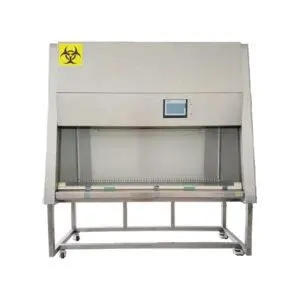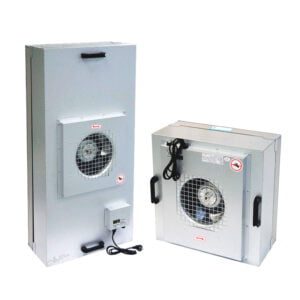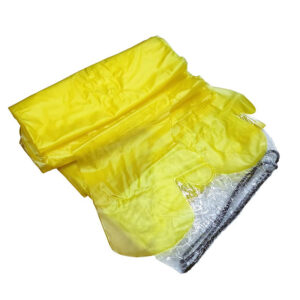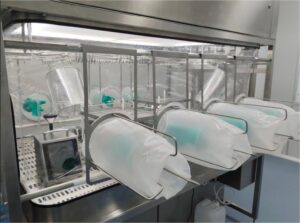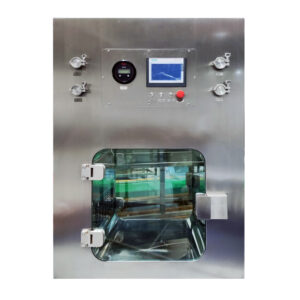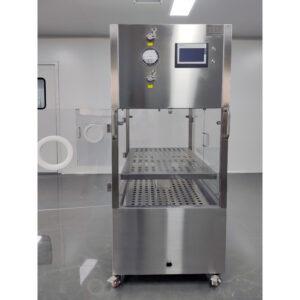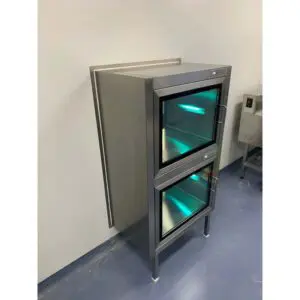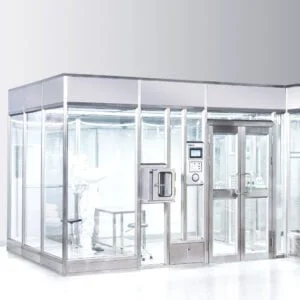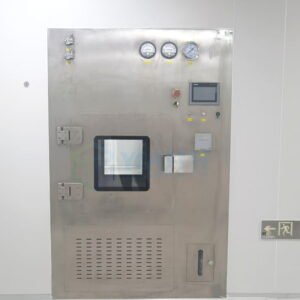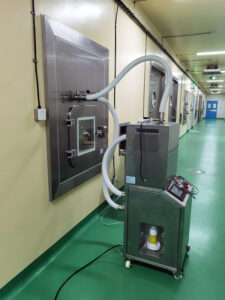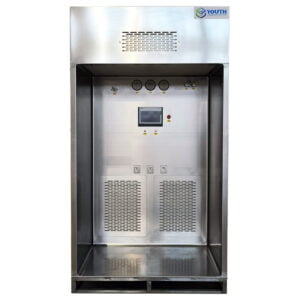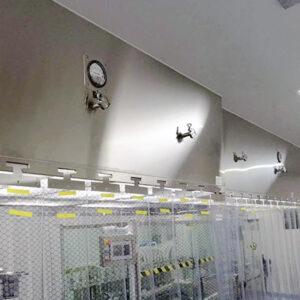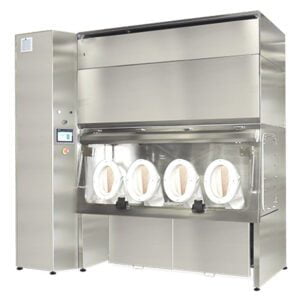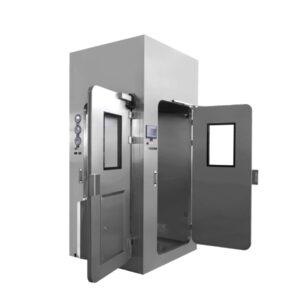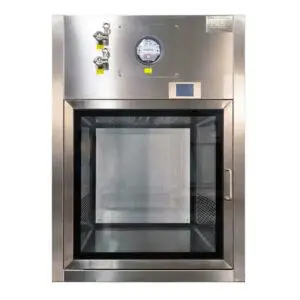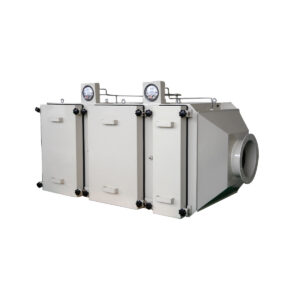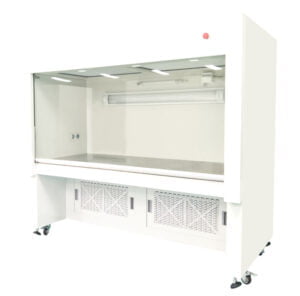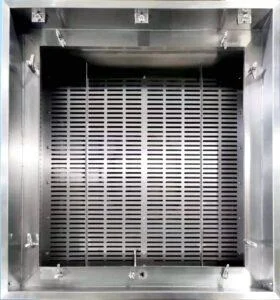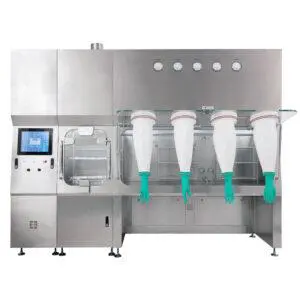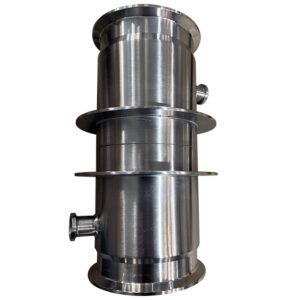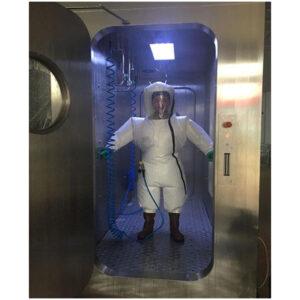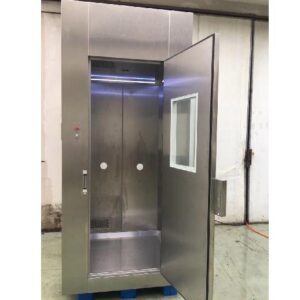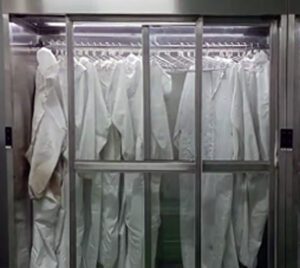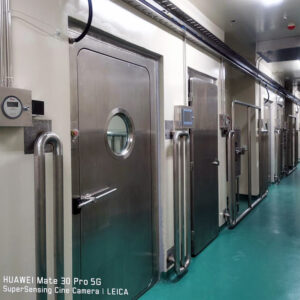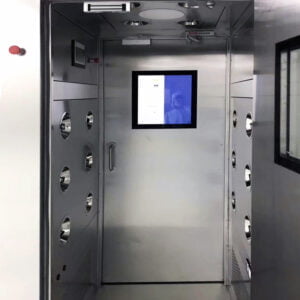Laminar flow hoods are essential tools in laboratories and cleanroom environments, providing a controlled, particle-free workspace for sensitive procedures. Understanding the dynamics of laminar flow hood airflow is crucial for maintaining sterility and protecting samples from contamination. This article delves into the intricacies of laminar flow hood airflow patterns, exploring their design, functionality, and applications across various industries.
As we explore the world of laminar flow hoods, we'll uncover the science behind their operation, the importance of proper airflow management, and the key factors that influence their performance. From the basics of laminar flow to advanced techniques for optimizing hood efficiency, this comprehensive guide will equip you with the knowledge needed to make informed decisions about laminar flow hood usage and maintenance.
Let's embark on a journey through the fascinating realm of laminar flow hood airflow dynamics, where precision and cleanliness converge to create the ideal environment for critical scientific and industrial processes.
Laminar flow hoods utilize carefully controlled airflow patterns to create a sterile work environment, protecting samples and operators from airborne contaminants while maintaining the integrity of sensitive materials and processes.
What is Laminar Flow and How Does it Work in a Hood?
Laminar flow is a type of fluid motion characterized by smooth, parallel layers of air or liquid moving in the same direction without mixing. In the context of a laminar flow hood, this principle is applied to create a controlled, particle-free environment for sensitive procedures.
The concept of laminar flow in hoods relies on the careful management of air movement to prevent turbulence and maintain a consistent, unidirectional flow. This is achieved through a combination of precise engineering and filtration technology.
At the heart of a laminar flow hood's operation is the HEPA (High-Efficiency Particulate Air) filter system. These filters are designed to remove 99.97% of particles 0.3 microns or larger from the air, ensuring a clean workspace. The filtered air is then pushed through the hood in a uniform, laminar pattern, creating a barrier against external contaminants.
Laminar flow hoods create a sterile work environment by forcing air through HEPA filters and maintaining a unidirectional flow, effectively sweeping particles away from the work surface and protecting samples from contamination.
| Component | Function |
|---|---|
| HEPA Filter | Removes 99.97% of particles ≥0.3 microns |
| Blower | Pushes air through the filter system |
| Plenum | Distributes air evenly across the work area |
| Work Surface | Provides a clean area for procedures |
The laminar flow pattern in these hoods is crucial for maintaining a sterile environment. As the filtered air moves across the work surface, it pushes any airborne particles away from the critical area, preventing contamination of samples or materials. This continuous, unidirectional flow is what sets laminar flow hoods apart from other types of clean air devices.
Understanding the dynamics of laminar flow is essential for properly utilizing these hoods and ensuring the integrity of your work. By maintaining the correct airflow patterns, you can create a reliable, contaminant-free workspace for a wide range of applications, from pharmaceutical research to electronics manufacturing.
How Do Vertical and Horizontal Laminar Flow Hoods Differ?
When it comes to laminar flow hoods, two main configurations dominate the market: vertical and horizontal flow hoods. Each design offers unique advantages and is suited to different applications, making it crucial to understand their differences.
Vertical laminar flow hoods direct filtered air downward from the top of the cabinet, creating a vertical curtain of clean air that flows over the work surface and exits through the front opening. This design is particularly effective at protecting samples from contamination, as the downward airflow immediately sweeps particles away from the work area.
Horizontal laminar flow hoods, on the other hand, push filtered air from the back of the cabinet horizontally across the work surface towards the operator. This configuration provides excellent product protection and is often preferred for applications where operator protection is less critical.
Vertical laminar flow hoods offer superior protection against airborne contaminants for both the sample and the operator, making them ideal for handling hazardous materials or highly sensitive samples.
| Feature | Vertical Flow | Horizontal Flow |
|---|---|---|
| Airflow Direction | Top to bottom | Back to front |
| Sample Protection | Excellent | Very good |
| Operator Protection | Good | Limited |
| Space Efficiency | More compact | Requires more depth |
| Energy Efficiency | Generally higher | Generally lower |
The choice between vertical and horizontal flow hoods depends on several factors, including the nature of the work being performed, the level of protection required, and the available space in the laboratory. Vertical flow hoods are often preferred in applications where both sample and operator protection are crucial, such as in microbiology or cell culture work. They also tend to be more space-efficient, as they can be designed with a smaller footprint.
Horizontal flow hoods excel in applications where product protection is the primary concern, such as in electronics assembly or certain pharmaceutical processes. They provide a clear, unobstructed view of the work area and can accommodate larger equipment or samples.
Understanding these differences is key to selecting the right YOUTH laminar flow hood for your specific needs. By carefully considering the airflow patterns and their implications for your work, you can ensure that you're creating the optimal environment for your critical procedures.
What Role Do HEPA Filters Play in Laminar Flow Hood Performance?
HEPA (High-Efficiency Particulate Air) filters are the cornerstone of laminar flow hood performance, playing a crucial role in creating and maintaining a clean, particle-free environment. These filters are designed to remove 99.97% of particles that are 0.3 microns in diameter or larger, which includes most bacteria, fungi, and other airborne contaminants.
The effectiveness of HEPA filters in laminar flow hoods lies in their complex structure and the principles of particle filtration. As air passes through the filter, particles are captured through a combination of mechanisms, including interception, impaction, and diffusion.
HEPA filters in laminar flow hoods are essential for achieving ISO Class 5 (Class 100) or better air cleanliness, ensuring a safe and sterile environment for critical procedures and sensitive materials.
| Particle Size (microns) | Filtration Efficiency |
|---|---|
| ≥ 0.3 | 99.97% |
| < 0.3 | > 99.97% |
| ≥ 0.12 | 99.99% |
The performance of HEPA filters in laminar flow hoods is not just about particle removal; it's also about maintaining consistent airflow. The filters are designed to provide uniform resistance across their surface, ensuring that the air passing through is evenly distributed. This uniformity is crucial for maintaining laminar flow and preventing turbulence that could compromise the sterile environment.
Regular maintenance and replacement of HEPA filters are essential for optimal laminar flow hood performance. As filters accumulate particles over time, their efficiency can decrease, potentially compromising the cleanliness of the work area. Most manufacturers recommend replacing HEPA filters every 3-5 years, depending on usage and environmental conditions.
Advanced laminar flow hoods may incorporate additional filtration technologies, such as ULPA (Ultra-Low Particulate Air) filters, which offer even higher efficiency, capturing 99.9995% of particles at 0.12 microns. These filters provide an extra level of protection for the most sensitive applications.
Understanding the role of HEPA filters in Laminar flow hood airflow patterns is crucial for maintaining the integrity of your clean workspace. By ensuring proper filter selection, installation, and maintenance, you can guarantee the highest level of air cleanliness and protect your critical processes from contamination.
How Does Air Velocity Impact Laminar Flow Hood Efficiency?
Air velocity is a critical factor in the performance of laminar flow hoods, directly impacting their ability to maintain a clean, particle-free environment. The speed at which air moves through the hood affects its laminar flow characteristics, particle removal efficiency, and overall protection capabilities.
Optimal air velocity in a laminar flow hood typically ranges from 0.3 to 0.5 meters per second (60 to 100 feet per minute). This range is carefully calculated to maintain laminar flow while effectively removing particles from the work area.
Maintaining the correct air velocity is crucial for laminar flow hood efficiency, as it ensures proper particle removal and prevents turbulence that could compromise the sterile environment.
| Air Velocity (m/s) | Impact on Performance |
|---|---|
| < 0.3 | Insufficient particle removal |
| 0.3 – 0.5 | Optimal laminar flow |
| > 0.5 | Potential turbulence and reduced efficiency |
Too low air velocity can result in insufficient particle removal and potential contamination of the work area. Conversely, excessive air velocity can create turbulence, disrupting the laminar flow and potentially introducing contaminants into the clean zone.
The impact of air velocity on laminar flow hood efficiency extends beyond particle removal. Proper air speed helps maintain a positive pressure within the hood, preventing the ingress of unfiltered air from the surrounding environment. This pressure differential is essential for protecting samples and materials from external contamination.
Air velocity also affects the energy efficiency of the laminar flow hood. Higher velocities require more power to maintain, potentially increasing operational costs. Striking the right balance between performance and energy consumption is crucial for long-term efficiency.
Regular monitoring and adjustment of air velocity are essential for maintaining optimal laminar flow hood performance. Many modern hoods are equipped with sensors and controls that allow for precise management of air speed, ensuring consistent protection and efficiency.
Understanding the relationship between air velocity and laminar flow hood efficiency is key to maximizing the performance of your clean air system. By maintaining the proper air speed, you can ensure a safe, sterile environment for your critical procedures while optimizing energy usage and operational costs.
What Factors Can Disrupt Laminar Flow Patterns?
Maintaining consistent laminar flow patterns is crucial for the effectiveness of laminar flow hoods. However, several factors can disrupt these carefully engineered airflow patterns, potentially compromising the sterility of the work environment.
One of the primary disruptors of laminar flow is the presence of obstacles within the hood. Equipment, materials, or even the operator's arms can create turbulence, breaking up the smooth, parallel layers of air flow. This turbulence can lead to the creation of eddies and vortices, potentially reintroducing contaminants into the clean zone.
Improper placement of equipment or excessive movement within the hood can significantly disrupt laminar flow patterns, increasing the risk of contamination and reducing the overall effectiveness of the clean air system.
| Disruptive Factor | Impact on Laminar Flow |
|---|---|
| Obstacles | Creates turbulence and eddies |
| Rapid Movements | Generates air currents |
| Thermal Gradients | Causes convection currents |
| Filter Damage | Compromises air distribution |
Rapid movements within the hood, such as quick hand motions or the sudden introduction of materials, can generate air currents that interfere with the laminar flow. These disturbances can persist for several seconds, potentially exposing samples to contamination.
Thermal gradients can also disrupt laminar flow patterns. Heat-generating equipment or temperature differences between the hood interior and the surrounding environment can create convection currents, interfering with the uniform airflow.
The condition of the HEPA filters and the overall hood structure plays a significant role in maintaining laminar flow. Damaged filters, leaks in the hood's seals, or issues with the blower system can all lead to uneven air distribution and compromised laminar flow.
External factors, such as air currents from nearby HVAC systems or frequently opened doors, can impact the hood's performance, especially if it's not properly positioned or shielded from these influences.
To minimize disruptions to laminar flow patterns, it's essential to follow best practices for hood operation. This includes proper placement of equipment, minimizing unnecessary movements, and maintaining a clean, well-organized workspace. Regular maintenance and testing of the hood, including filter integrity checks and airflow visualization studies, can help identify and address potential issues before they compromise the sterile environment.
Understanding and mitigating the factors that can disrupt laminar flow patterns is crucial for ensuring the reliability and effectiveness of your laminar flow hood. By being aware of these potential issues and taking proactive steps to address them, you can maintain a consistently clean and safe working environment for your critical procedures.
How Can Laminar Flow Hood Performance Be Optimized?
Optimizing the performance of a laminar flow hood is essential for maintaining a sterile environment and ensuring the integrity of sensitive procedures. Several strategies can be employed to enhance the efficiency and reliability of these critical clean air systems.
Regular maintenance is the cornerstone of optimal laminar flow hood performance. This includes routine cleaning of the work surface and interior, checking and replacing filters as needed, and inspecting the hood for any signs of wear or damage. A well-maintained hood not only performs better but also has a longer operational life.
Implementing a comprehensive maintenance schedule and adhering to strict operational protocols can significantly enhance laminar flow hood performance, ensuring consistent protection for sensitive materials and processes.
| Optimization Strategy | Impact on Performance |
|---|---|
| Regular Maintenance | Ensures consistent operation |
| Proper Training | Minimizes user-induced errors |
| Airflow Monitoring | Maintains optimal velocity |
| Environmental Control | Reduces external influences |
Proper training for all users is crucial. Operators should understand the principles of laminar flow, proper work practices within the hood, and the importance of minimizing disruptions to the airflow. This knowledge helps prevent user-induced errors that could compromise the sterile environment.
Implementing advanced airflow monitoring systems can help maintain optimal performance. These systems can provide real-time data on air velocity and filter efficiency, allowing for immediate adjustments if necessary. Some modern hoods even incorporate smart technologies that can alert users to potential issues before they become critical.
Controlling the environment around the laminar flow hood is also important for optimization. This includes managing room temperature and humidity, minimizing air currents from HVAC systems or foot traffic, and properly positioning the hood away from doors or other sources of disruption.
Regularly conducting performance tests, such as smoke studies and particle counts, can help verify the hood's effectiveness and identify any areas for improvement. These tests can reveal subtle issues that might not be apparent during normal operation.
Customizing the hood's configuration to suit specific applications can also enhance performance. This might involve adjusting the airflow pattern, incorporating additional filtration stages, or modifying the work surface to accommodate specialized equipment.
Energy efficiency should also be considered when optimizing laminar flow hood performance. Implementing energy-saving features, such as occupancy sensors or variable speed blowers, can reduce operational costs without compromising protection.
By focusing on these optimization strategies, laboratories and cleanroom facilities can ensure that their laminar flow hoods consistently provide the highest level of protection for sensitive materials and processes. This commitment to performance optimization not only enhances the quality of work but also contributes to overall operational efficiency and reliability.
What are the Latest Innovations in Laminar Flow Hood Technology?
The field of laminar flow hood technology is continuously evolving, with new innovations aimed at improving performance, efficiency, and user experience. These advancements are reshaping the way we approach clean air systems in laboratory and industrial settings.
One of the most significant recent developments is the integration of smart technologies into laminar flow hoods. These intelligent systems incorporate sensors and data analytics to provide real-time monitoring of airflow patterns, filter efficiency, and overall hood performance. This allows for proactive maintenance and immediate response to any deviations from optimal conditions.
Advanced laminar flow hoods now feature IoT connectivity and AI-driven performance optimization, revolutionizing the way we monitor and maintain clean air environments in critical applications.
| Innovation | Benefit |
|---|---|
| Smart Sensors | Real-time performance monitoring |
| IoT Connectivity | Remote management and data logging |
| Energy-Efficient Designs | Reduced operational costs |
| Modular Configurations | Enhanced flexibility and customization |
The integration of Internet of Things (IoT) technology is another groundbreaking innovation in laminar flow hood design. IoT-enabled hoods can be remotely monitored and controlled, allowing for centralized management of multiple units across different locations. This connectivity also facilitates comprehensive data logging and analysis, which can be invaluable for regulatory compliance and process optimization.
Energy efficiency is a major focus of recent innovations. New designs incorporate variable speed motors and smart power management systems that adjust airflow based on actual usage, significantly reducing energy consumption without compromising protection.
Advancements in filter technology are also pushing the boundaries of laminar flow hood capabilities. Next-generation ULPA filters offer even higher particle removal efficiency, while new filter designs aim to reduce pressure drop and extend filter life.
Modular and customizable hood designs are gaining popularity, allowing users to tailor their clean air systems to specific applications. These flexible configurations can accommodate a wide range of equipment and processes, improving workflow efficiency.
Ergonomic improvements are another area of innovation, with new designs focusing on user comfort and accessibility. Features like adjustable work surfaces, improved lighting systems, and intuitive control interfaces are enhancing the user experience and reducing operator fatigue.
Some manufacturers are exploring the integration of UV sterilization technology within laminar flow hoods, providing an additional layer of protection against biological contaminants.
As the demand for cleaner, more controlled environments continues to grow across various industries, these innovations in laminar flow hood technology are paving the way for more efficient, reliable, and user-friendly clean air solutions. By staying abreast of these advancements, laboratories and cleanroom facilities can ensure they are leveraging the most effective tools for their critical processes.
Conclusion
Understanding the dynamics of laminar flow hood airflow is crucial for maintaining sterile environments in laboratories, cleanrooms, and various industrial settings. From the basic principles of laminar flow to the latest technological innovations, this comprehensive exploration has highlighted the importance of proper airflow management in protecting sensitive materials and processes.
We've delved into the differences between vertical and horizontal flow hoods, the critical role of HEPA filters, and the impact of air velocity on hood efficiency. We've also examined the factors that can disrupt laminar flow patterns and strategies for optimizing hood performance. The latest innovations in laminar flow hood technology, including smart sensors, IoT connectivity, and energy-efficient designs, promise to further enhance the capabilities and reliability of these essential clean air systems.
As we continue to push the boundaries of scientific research, manufacturing precision, and quality control, the importance of laminar flow hoods in maintaining controlled environments cannot be overstated. By leveraging the knowledge and insights presented in this article, professionals across various industries can make informed decisions about selecting, operating, and maintaining laminar flow hoods to ensure the highest standards of cleanliness and protection for their critical work.
The future of laminar flow hood technology looks promising, with ongoing advancements aimed at improving performance, efficiency, and user experience. As these innovations continue to emerge, staying informed and adaptable will be key to maximizing the benefits of these sophisticated clean air solutions.
External Resources
Laminar Flow Hood: Discover Its Functioning and Utility in the Laboratory – This article explains the functioning and utility of laminar flow hoods in laboratory environments, including their main components such as HEPA filters, fans, and control panels, and their applications in various scientific fields.
Laminar Flow Hood Design | What is Important? – This resource delves into the design considerations of laminar flow hoods, focusing on the importance of fan and filter specifications, air flow speeds, and the uniformity of air flow to maintain laminar conditions.
Horizontal and Vertical Laminar Flow Hoods – This article compares horizontal and vertical laminar flow hoods, discussing the differences in airflow patterns, the location of HEPA/ULPA filters, and the appropriate applications for each type.
Airflow patterns in Biological Safety Cabinets and Laminar Flow Hoods – This video demonstrates the differences in airflow patterns between biological safety cabinets and laminar flow hoods, highlighting their distinct operational characteristics.
Smoke test for cleanroom: not only airflow visualization – Although not exclusively about laminar flow hoods, this resource discusses methods for visualizing and measuring airflow patterns, which can be relevant for ensuring the proper functioning of laminar flow hoods.
Laminar Flow Hoods – Air Science – This page provides detailed information on Air Science's laminar flow hoods, including their configurations, sizes, and specific models, along with the benefits of using vertical or horizontal laminar airflow.
Related Contents:
- Vertical Laminar Flow Hoods: Optimal Protection
- Horizontal Laminar Flow Hoods: Uses and Benefits
- Laminar Flow Hood vs BSC: Choosing Wisely
- Laminar Flow Hood Certification: Ensuring Quality
- Laminar Flow Hood Cleaning: Step-by-Step Guide
- HEPA Filter Efficiency: Maximizing Air Purification
- Airflow Patterns in Sterility Test Isolators: Design Guide
- Airflow Velocity Testing for Mobile LAF Carts
- Airflow Control in Mobile LAF Carts: Expert Guide


